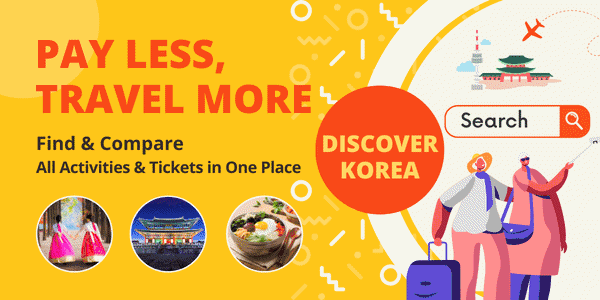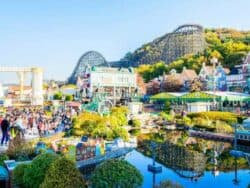While there are many sights and intriguing things to discover in Seoul, Cheongwadae (Blue House) has recently become one of the city’s most intriguing and mysterious attractions. This is where Korean presidents live and work, much like the White House in the United States; thus, it’s always highly secure. However, the mystery surrounding Cheongwadae was lifted in 2022 when President Yoon Suk Yeol chose not to reside there and allowed visitors to admire the building’s legacy and significance. Therefore, make time to see this unique location if you are in Seoul. This article will cover all you need to know about visiting Cheongwadae.
Read also:
- Ultimate Guide to Gyeongbokgung Palace in Seoul
- Free Incheon Airport Transit Tours
- Sindangdong Hot Places: Cafes, Restaurants, Pubs
- About Cheongwadae (The Blue House)
- The history of Cheongwadae (The Blue House)
- Why it is called The Blue House
- How to get there
- How to visit Cheongwadae (The Blue House)
- Rules and tips for visiting Cheongwadae (The Blue House)
- What to see in Cheongwadae
- Main building of the Blue House (Cheongwadae)
- Yeongbingwan
- The Presidential Residence
- Sangchunjae
- Nokjiwon Garden
- Mugunghwa (Rose of Sharon) Hill
- Chunchugwan (춘추관)
- Chilgung Palace (칠궁)
- Ounjeong Pavilion
- Chimryugak Pavilion
- Stone-Seated Buddha from the Unified Silla
- Suggested routes for visiting Cheongwadae (the Blue House)
- Nearby attractions
About Cheongwadae (The Blue House)

Cheong Wa Dae, also known as the Blue House, served as the official residence and office of the South Korean President for 74 remarkable years, from 1948 to 2022. Nestled amidst the scenic backdrop of Bugaksan Mountain in the heart of Seoul, this iconic complex witnessed pivotal moments in Korean history. It was a powerful symbol of the nation’s government and leadership.
General information:
- Address: 1 Cheongwadae-ro, Jongno-gu, Seoul
- Visiting Hours: March-November 9:00 – 18:00 (Last admission for indoor viewing at 17:30) | December-February 9:00 – 17:30 (Last admission for indoor viewing at 17:00) | Closed on Tuesdays
- Admission: Free
- Tour’s operating hours: 09:00, 10:30, 12:00, 13:30, 15:00, 16:30
- Website: www.opencheongwadae.kr
The history of Cheongwadae (The Blue House)

The grounds where the Blue House stands have a rich history. Initially a royal villa during the Goryeo Dynasty in Hanyang, it later became the back garden of Gyeongbokgung Palace in the Joseon era. During the Japanese occupation, it transformed into a government administrative building. In 1948, with the establishment of the Republic of Korea, President Syngman Rhee renamed it “Gyeong Mu Dae” and used it as both an office and residence.
The fourth president, Yun Bo-seon, later changed the name to Cheongwadae, meaning “The Blue House,” due to the distinctive blue tiling on the roof. Until the presidency of Yoon Suk-Yeol, all Korean presidents utilized it for official and residential purposes. However, in 2022, following a Presidential decree, the Blue House was designated a public park and opened to the public for the first time. The excitement among citizens and tourists led to a reservation system, allowing up to 6,500 people to explore this historic site every two hours.
Why it is called The Blue House
The Blue House is believed to get its name from the Korean nickname for Cheongwadae, characterized by its enduring blue-tiled roof. Despite various renovations enhancing the presidential residence, the iconic blue roof has remained a constant. Interestingly, dating back to the Goryeo Dynasty, there was a belief that a home with a blue roof symbolized wealth. This choice of a blue-tiled roof for the Blue House might be a historical expression symbolizing the nation’s prosperity.
How to get there
Car to Cheonghwadae
The Blue House does not have a parking lot for visitors, so it is advisable to get there by taxi or public transportation. If driving is your only option, you must park in a nearby public lot.
The closest parking lot is Cheongwadae Sarangchae. The walk to the front gate is about 6 minutes by foot. It is 300 won for every 5 minutes. For one hour, it is 3,600 won. The average time to visit just the main building of the Blue House was 1 hour. We went on Christmas Day at around 10:30 a.m. The parking lot was not crowded, and there were several spots available.

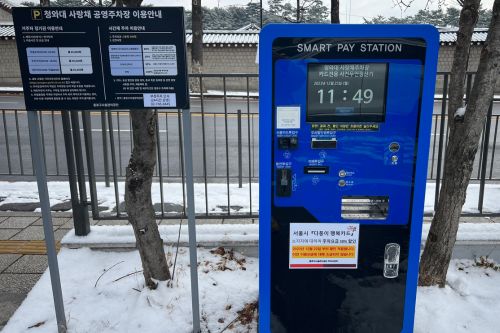
Cheongwadae Sarangdae Parking Lot Address: 196 Hyoja-dong, Jongno-gu, Seoul, South Korea
Bus or Subway to Cheongwadae
Getting there by public transportation: This is the best way to get to the Blue House. Fast and cheap. Get on the subway line 3 and exit via Exit 4 at Gyeongbokgung Station. You can walk for about 15 minutes to get to the Cheongwadae or catch a bus to get closer. At the Gyeongbokgung Station bus stop, board bus nos. 1711, 1020, 7018, 7016, 7022, or 7212, and get off at the Hyoja-dong bus station.
Taxi to Cheongwadae
Getting there by taxi: This is also a great option because you can flag down a taxi wherever you are. Just tell the driver that you want to go to the Blue House (Cheongwadae) or give them the address. The address is 1 Cheongwadae-ro, Jongno-gu, Seoul. Use the Kakao taxi app for fast riding.
You can hit two stones with one bird by visiting the Gyeongbokgung Palace and exiting the back gate towards Cheongwadae. But the back gate can be closed, so ask when you buy the palace tickets. Here is everything you need to know about Gyeongbokgung Palace.


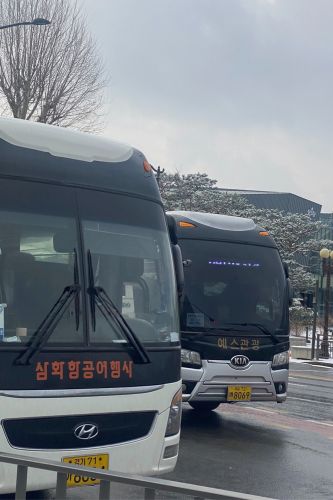
Seoul City Tour Bus to Cheongwadae
Another great way to view the Blue House is by going on the Seoul City Tour Bus. On the Seoul City Tiger Red Tour Bus, get on the Downtown Palace & Namsan Course and stop at the Front of Cheong Wa Dae (Blue House). The Yellow Balloon City Tour Bus has stops at the Blue House on both the Traditional Culture (Weekly) Course and the Seoul Night View Course.
How to visit Cheongwadae (The Blue House)

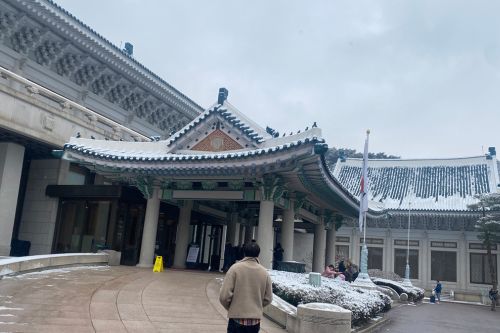
Make a reservation
A reservation on the official website is required to visit Cheongwadae. You can make a reservation by going to the official website (here), filling out the online reservation form, and specifying your preferred visit date.
A reservation confirmation code will be sent to your mobile phone within the day (Notification will be sent to the winners only). To register on the official website, you must have a local phone number, which you can get by purchasing a sim card at Incheon Airport when you arrive in Korea. Reservations can be made up to 4 weeks in advance, and up to 6 people can be registered per reservation.
You can register on-site at the Main Gate’s General Information Center if you don’t have a local phone number. However, only 500 visitors per session and up to 2000 visitors per day are permitted. Still, making a reservation online beforehand is best to ensure you can join the tour. Remember to bring the necessary identification (such as your passport or Alien Registration Card) for verification if you register on-site.
On the day of the tour


You are supposed to meet at the main entrance at the Cheong Wa Dae Tour Information Booth on the day of the tour. Aim to arrive between 20 and 30 minutes before the start of your trip. Bring your confirmation code or, if enrolling in person, your passport to be admitted to the tour.
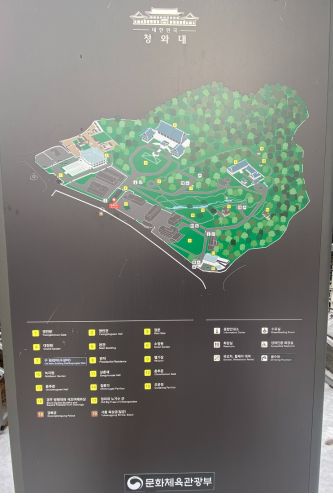


Rules and tips for visiting Cheongwadae (The Blue House)
- Smoking is prohibited on the Cheong Wa Dae premises, buildings, or grounds.
- Visitors are advised to bring an umbrella and bottles of water.
- Because this is an official landmark, you should dress formally and avoid revealing clothing and shorts.
- Arrive at the meeting point at least 20 minutes before the start of your tour.
- Photographs of Cheong Wa Dae are permitted only at particular spots on the tour. If you don’t speak Korean, you’ll know it’s okay to take photos when the rest of the group does.
What to see in Cheongwadae
Walking into Cheongwadae, you can feel everyone’s excitement at seeing a building shuttered for so long. It appears to be a fancy building, and visiting cultural monuments is always interesting since you can sense the history when you walk around. Here are some important attractions in Cheongwadae that you can consider to visit:
Main building of the Blue House (Cheongwadae)
This location is the most popular spot in Cheongwadae and is recognized for its distinctive blue roof. The traditional Korean-style building boasts about 150,000 blue tiles, creating an impressive look. Originally, it was where the presidents did their work and hosted guests, but now it’s open to the public as a museum showcasing the lives of past presidents.
Each room has its own story, and in the Mugunghwa Room, you can check out a display featuring all the First Ladies of South Korea. Because of its popularity, the line here is often so long, so if you find it too long, you can visit other locations first and then return here at the end of your Cheongwadae journey.
Here are some more pictures of each room in the Main Building of the Blue House.
Sejong Room, Portraits of the Presidents of South Korea
This room is the first room on the West side of the main building of the Blue House. It has portraits of the first 12 presidents of South Korea and is also the place where governmental policies were made.



Mugunghwa Room, First Lady’s Office
The first thing you will see when you enter the Mugunghwa Room is the portraits of the First Ladies of South Korea. This is the First Lady’s office space, where she met with other foreign leaders. It was wonderful seeing the antique furniture and imagining the daily life of the First Lady.

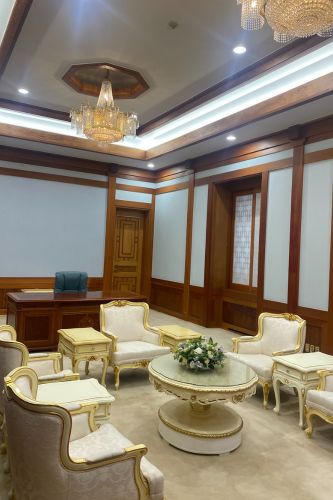

Chungmu Room, Host Large Meetings
This room in the East wing of the main building was where many leaders gathered for meetings and dinners. The floor is carpeted and big enough to hold large crowds.
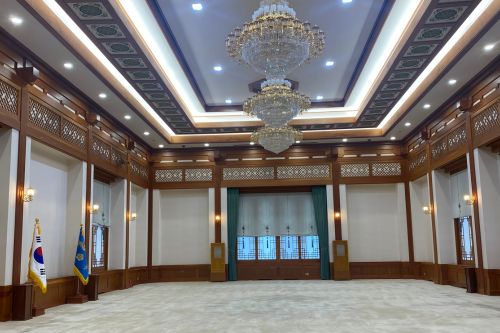

Inwang Room
This Western-style room in the East Wing of the main building was where small banquets, lunches, and dinners were held. The Room is named after the Ingang mountain, west of Cheongwadae. The creme interior walls and big blue painting with the small garden in the back is surely a great place for appointments.


Reception Room
The President of Korea had meetings with other foreign leaders in the reception room, which had many Korean elements. The Hanji wallpaper, Korean painting, and wooden windows complement each other.


Presidential Office
The background of the Presidential Office is where the President has been seen the most, especially in the news. It looked exactly like on TV, so I felt I was on a movie set. I was also amazed by the lighting, which was dragon-designed. They indeed had the best furniture and paintings.
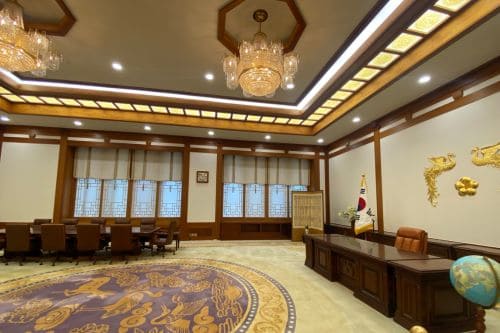

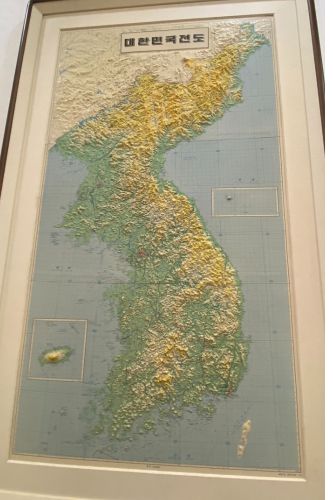
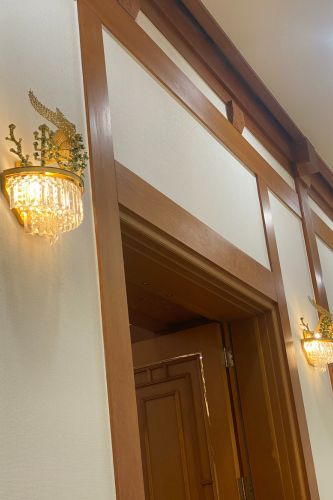
Yeongbingwan

Yeongbingwan serves as the state reception hall, hosting significant meetings and official events for state guests. When foreign leaders visit Korea, they are greeted with traditional Korean performances and dinner banquets in this space. Additionally, the President utilizes Yeongbingwan for hosting large meetings or banquets accommodating over 100 guests. The interior boasts a spacious and solemn atmosphere, with yellow and white as the primary colors.
The Presidential Residence

Apart from the main structure, this served as the residence for presidents and their families during their term in office. It comprises residential quarters (Bonchae) and a detached reception area (Byeolchae). There is also a large front area with a garden designed in the traditional Korean manner and separate men’s quarters (Sarangchae).
Sangchunjae
Designed in the traditional Hanok style, Sangchunjae is a venue where traditional Korean artwork is showcased to guests. It is also utilized for receptions and informal meetings. A yard adorned with various flowers in the front creates a serene and picturesque setting.
Nokjiwon Garden

Nokjiwon is the most scenic outdoor space at Cheong Wa Dae. This garden is ideal for leisurely walking and relaxing on a beautiful day. The area features a diverse collection of trees, including up to 120 kinds, with each president contributing commemorative trees.
Mugunghwa (Rose of Sharon) Hill
Mugunghwa Valley, named after Korea’s national flower, was previously the site of the Korean Central Intelligence Agency’s Gungjeong-dong safe house. Today, it has been repurposed into a public park, providing a serene and recreational space for visitors to enjoy.
Chunchugwan (춘추관)

Constructed in 1990, this facility serves as the venue where the President addresses the media and the nation and where the Presidential Press Secretary conducts news briefings. You will probably find the scene here familiar if you study Korean and frequently follow Korean news.
“Chunchugwan” derives from Chungchugwan, Goryeo’s recordkeeping office, and Joseon’s Yemun Chunchugwan. This name reflects the impartial recordkeeping traditions of these historical offices and aligns with the principle of freedom of the press.
Chilgung Palace (칠궁)

This structure’s name directly translates to “Seven Palaces.” It houses the spirit tablets of the seven concubines who gave birth to Joseon Dynasty kings. According to Confucian traditions, respecting your elders in life and honoring them in death is vital; hence, their spirits must be maintained in tablets like this.
Ounjeong Pavilion
Ounjeong Pavilion, named after Oungak in the rear garden of Gyeongbokgung Palace, was relocated in 1989 during the construction of the Cheong Wa Dae Presidential Residence building. It holds the esteemed status of being a registered tangible cultural heritage in Seoul.
Chimryugak Pavilion
This is a long-standing pavilion preserving many historical and cultural values of Korea. It was moved in 1989 during the construction of the Cheong Wa Dae Presidential Residence and is recognized by the Seoul Metropolitan Government as a Tangible Cultural Heritage.
Stone-Seated Buddha from the Unified Silla
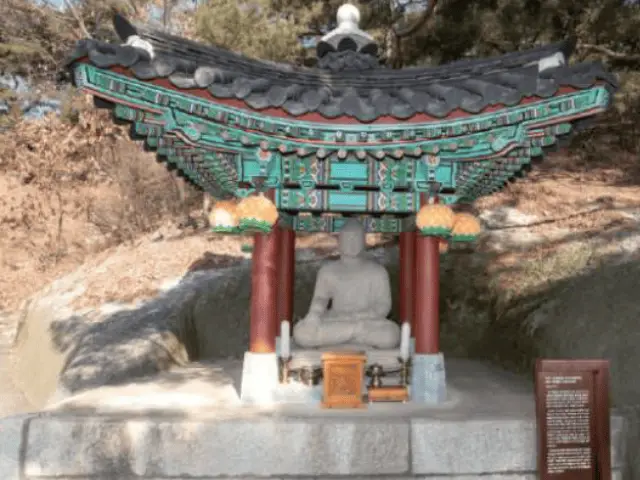
Originally crafted during the Unified Silla period in the 9th century, this Buddha sculpture has been housed in the Japanese Government-General Museum since 1912. However, it was relocated to its current position in 1989 when the Cheong Wa Dae Presidential Residence Building was constructed. Acknowledging its historical significance, the state formally recognized and designated it as a Treasure on April 20, 2018.
Suggested routes for visiting Cheongwadae (the Blue House)

Because there are so many attractions in Cheongwadae, it isn’t easy to visit them all at once, so they propose many routes suitable for different purposes. Here are some routes that you can consider.
1. Exploring history and culture
- Stops: Nokjiwon → Sangchunjae → Old main building site → Main building →Yeongbingwan
- Duration: 60mins
2. Exploring cultural heritage
- Stops: Chimryugak Pavilion → Ounjeong Pavilion → Stone Seated Buddha from the Unified Silla
- Duration: 30mins
3. Exploring the grounds
- Stops: Sangchunjae → Presidential Residence → Old main building site → Small garden → Yeongbingwan
- Duration: 60mins
4. For family and children
- Stops: Yeongbingwan → Main building → Nokjiwon → Chunchugwan
- Duration: 30mins
Nearby attractions
Gyeongbokgung Palace

Situated right beside the Cheongwadae, Gyeongbokgung is absolutely a must-visit spot. Constructed in 1394 by Taejo, the first Joseon king, it is the largest among the five palaces and was the main palace during the Joseon dynasty. Exploring this historical site provides a beautiful glimpse into traditional Korean culture. Wearing a hanbok, wandering around the palaces, and taking amazing photos are experiences every visitor would love to try. In addition, if you wear a hanbok to this site, you will receive a free admission ticket.
- Address: 161 Sajik-ro, Jongno-gu, Seoul
- Open hours: 9:00 – 18:00 daily | closed on Mondays
- Phone: +82 2-3700-3900
- Website: www.royalpalace.go.kr
Tongin Market

Tongin Market, near Cheong Wa Dae, has a rich history dating back to 1941 during the Japanese occupation. Unlike supermarkets, it’s a traditional market with a personal touch, preserving Seoul’s past for visitors to explore.
The unique thing about Tongin Market is that you have to use traditional Korean coins or yeopjeon in Korean to shop or get some food here. Paying with these vintage coins is like traveling back in time and a unique cultural experience. You can grab these rare brass coins at the market’s Customer Service Center until 3 PM.
With around 80 stores, this traditional Korean market is a treat for your eyes and taste buds. Dig into delights like the famous gireum tteokbokki (stir-fried tteokbokki) and dak-kkochi (chicken skewers). You can also browse through prop stores with items from the good old days.
- Address: 18 Jahamun-ro 15-gil, Jongno-gu, Seoul
- Open hours: 7:00 – 21:00 daily
- Phone: +82 2-722-0911
MMCA (National Museum of Modern and Contemporary Art) Seoul

If you’re into art, you have to check this place out. The museum has a cool mix of history and politics from the Joseon Dynasty to the post-Korean War era. What’s unique is the traditional Korean courtyard setup, giving it a laid-back feel. The building blends well with the landscape, and inside, you’ve got neat facilities like a reference center, a gallery theater, and a multipurpose hall.
- Address: 30 Samcheong-ro, Jongno-gu, Seoul
- Open hours: 10:00 – 18:00 on Sunday, Monday, Tuesday, Thursday, Friday | 10:00 – 21:00 on Wednesday and Saturday
- Phone: +82 2-3701-9500
- Website: www.mmca.go.kr
In conclusion, we hope this information is useful for you in planning your upcoming trip to Cheongwadae. We don’t know whether future presidents will come to live here, so if you’re in Seoul, take advantage of this once-in-a-lifetime opportunity. I wish you a pleasant journey!
IVK’s Top Picks – Day Tours, Tickets, and Travel Activities
Seasonal Picks!😍



